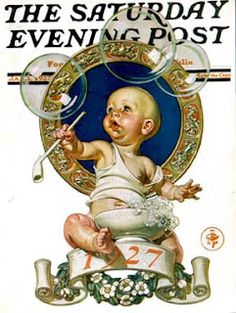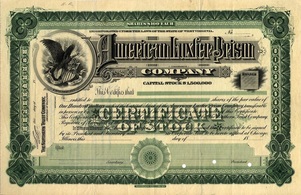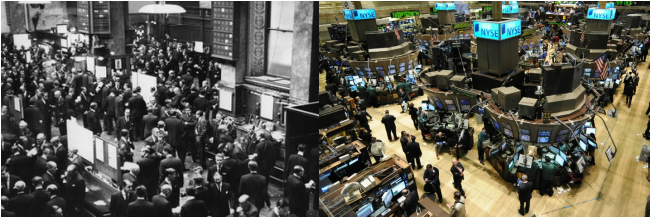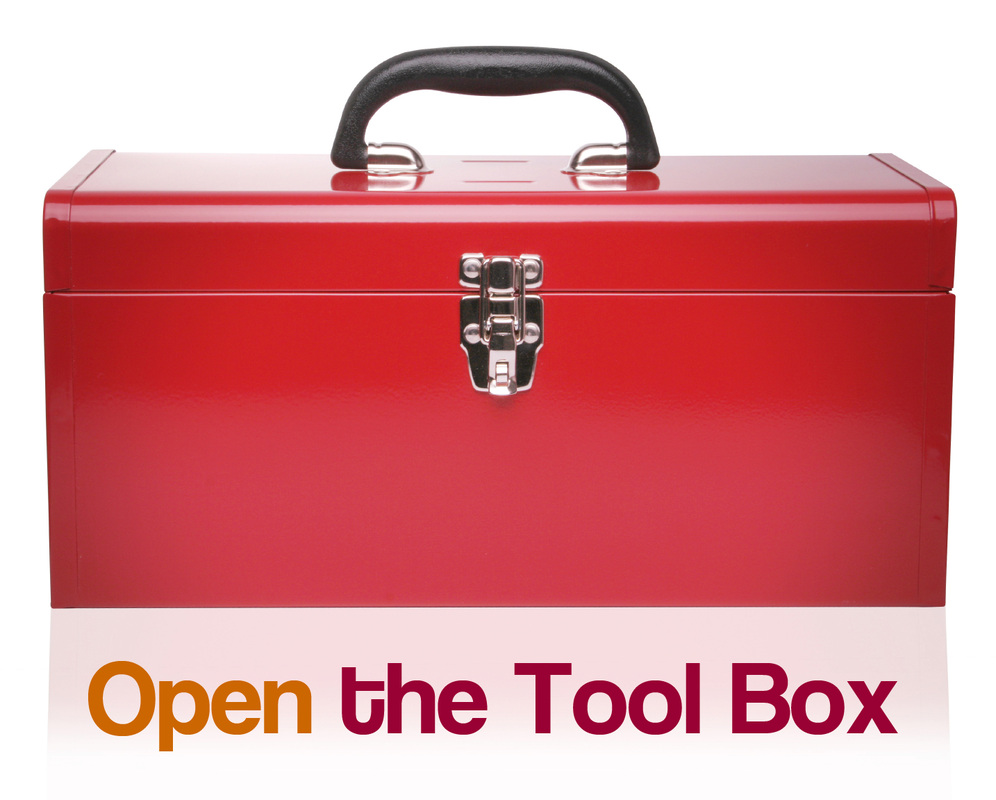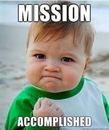Unit 4: The 1920s and 1930s
Lesson 12: Stock Market Crash of 1929
FOCUS ACTIVITY
I Can Do It!

I can explain the Stock Market Crash of 1929.
TEACHING ACTIVITY
Guided Reading

DIRECTIONS: We are now going to read today's text as a class. Remember to follow along. I will select readers randomly by calling out numbers. Important terms, people, places, and events are highlighted in the toolbox.
CRASH!
Oh hush thee, my babe, granny's bought some more shares,
Daddy's gone out to play with the bulls and the bears,
Mother's buying on the tips and she simply can't lose,
And baby shall have some expensive new shoes.
~ Saturday Evening Post ~
Daddy's gone out to play with the bulls and the bears,
Mother's buying on the tips and she simply can't lose,
And baby shall have some expensive new shoes.
~ Saturday Evening Post ~
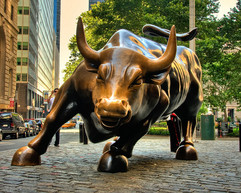 The Wall Street Bull sits outside of the Wall Street Stock Exchange in New York City.
The Wall Street Bull sits outside of the Wall Street Stock Exchange in New York City.
The business of buying and selling stocks is called the stock market. The place where stocks are bought and sold is called the stock exchange. The most important stock exchange is in New York City on Wall Street. Brokers from all over the world can call Wall Street with orders to buy and sell.
The stock market usually reflects the business world. If things are going well, stocks go up. If business is poor, stocks go down Brokers have a name for an “up” market. They call it a bull market. A down market is a bear market. The 1920s were a prosperous time. Around 1924, the stock market started rising. At first it was a slow, moderate rise. Then the bulls got frisky!
WE ARE THE CHAMPIONS
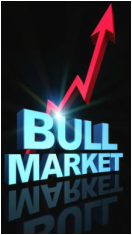
In 1927, the market began to rise like fury. Almost overnight, stocks doubled and sometimes tripled in value. Everyone was talking about it. Newspapers wrote about it. The country’s political leaders were all smiling. They felt it was their good leadership that was causing it. The business leaders were happy too. Of course they thought it was their good business sense that was causing the stock market boom. Many politicians and business leaders were saying that something new was happening. They said that the boom would just go on and on. They said there was not going to be an end to it. And it wasn’t just the political and business leaders who were saying all of this. Professors from the nation’s great universities were saying the same thing.

Now, suppose you were living in 1927. All your friends are getting rich and you aren’t. You feel like a dummy, don’t you? Why don’t you take all your savings and buy as many stocks as you can? Buy them on margin so you can get lots of shares for your money. That’s the smart thing to do, say many business experts.

So that is just what you do - in July of 1929. And some of your friends do it too. The stock boom is incredible before July. That summer it is fantastic. Some people are buying stock in anything. It doesn’t matter if the company has any real worth or not. No one seems to care. Just give me stock and more stock, I want to get rich! The stock ballon grows bigger, and bigger, and bigger! And guess what happens? Picture the balloon being pumped up. Now watch that pin. You thought the balloon went up fast? Well, whoosh, it will come down much faster.
I'M A LOSER BABY!
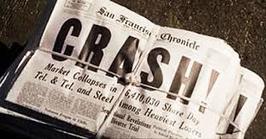
On October 24, 1929 - Black Thursday, it happens! It was the day of reckoning. It was called the “panic”. People go wild trying to sell. But now almost no one wants to buy. The stock market begins to crash! On Tuesday, October 29, 1929 the stock market crashed! The day the stock market crashed became known as Black Tuesday.
Remember that $100 stock you bought on margin for $10? Well, when the price drops, your broker sells too. Too bad - you lose your $10. No, it’s worse than that. You see, you owe $90 on that stock. Deduct from the $90 the price your broker gets when he sells the stock. You owe the rest. But you bought 100 shares of stock - or was it 1,000 or 10,000? You put all your savings into the stock market. The experts said it was the smart thing to do.
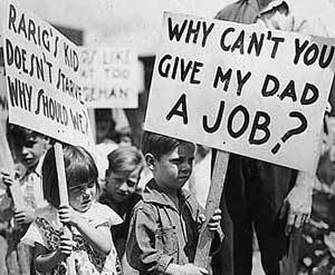 During the Great Depression many people were out of work.
During the Great Depression many people were out of work.
Sorry, you owe the money. Oh, you don’t have any money? You could sell your house, or your car, or both. You just lost your job too? You worked at the ABC Auto Company. Oh that’s just too bad! Most people have just stopped buying cars. Now the company is losing money. It has to sell its beautiful new plant. Why doesn’t it sell stock to try to raise money? Are you kidding? No one is buying stock now!
The banks are in trouble too. The banks lent money to brokers and all those people who were buying stocks. Now, they have no money. They are closing their doors too. What is happening in America? We’re having a depression. It will go on for 10 years. Many people will lose everything! Many others will be out of work. The country will be in terrible shape.
The banks are in trouble too. The banks lent money to brokers and all those people who were buying stocks. Now, they have no money. They are closing their doors too. What is happening in America? We’re having a depression. It will go on for 10 years. Many people will lose everything! Many others will be out of work. The country will be in terrible shape.

Years later, economic historians will look at the wild stock market boom and the awful depression and say that it didn’t have to happen. If there had been good leadership and sensible regulations, the depression could have been prevented.
WHOLE GROUP ACTIVITY
Understanding Concepts
DIRECTIONS: In this activity, we will discuss the answers to the following questions:
1. What is a stock? How do stocks play a part in company ownership?
2. Who are stockholders? How do they make money?
3. What is the law of supply and demand? How does it play a part in our economy in the U.S.?
4. What was buying on a margin? How did buying on a margin contribute to the stock market crash?
5. What was Black Thursday? How did it lead to the Stock Market Crash?
6. What was the Stock Market Crash of 1929? What impact did it have on Americans? What impact did it have on
the American economy?
1. What is a stock? How do stocks play a part in company ownership?
2. Who are stockholders? How do they make money?
3. What is the law of supply and demand? How does it play a part in our economy in the U.S.?
4. What was buying on a margin? How did buying on a margin contribute to the stock market crash?
5. What was Black Thursday? How did it lead to the Stock Market Crash?
6. What was the Stock Market Crash of 1929? What impact did it have on Americans? What impact did it have on
the American economy?
SMALL GROUP ACTIVITY
Support Your Cause
DIRECTIONS: In this activity, we will play a very simple stock market simulation game. Each team will be a household. Each household will be given $500. You will each have a chance to buy stock in several different companies. I will draw event cards after everyone has purchased the stock they want. The event cards will cause stock prices to go up or down. Each group will then have the opportunity to buy or sell stocks at the new price. This will continue until I call time. The group who cashes out their stock and has the most money at the end of the game is the winner.
Questions:
1. What events cause stock prices down? What events cause them to go up?
2. When is the best time to sell stocks? Why?
3. What was your strategy in buying and selling stocks? Did it work? Why or why not?
Questions:
1. What events cause stock prices down? What events cause them to go up?
2. When is the best time to sell stocks? Why?
3. What was your strategy in buying and selling stocks? Did it work? Why or why not?
INDIVIDUAL ACTIVITY
Exit Pass
DIRECTIONS: In this activity you answer prove that you have met the Lesson Mission by answering the essential question of the lesson. Please complete the exit pass below. You will have two chances to take the pass off. The highest score will be taken for a grade. You may use the reading to help you.
HOMEWORK
Finish the Lesson and Family Time

Remember, you have homework every night in Social Studies. First, share with your family what you learned in class today. Second, review your exit pass response to each lesson and the lesson vocabulary to help you study for the test.
END OF THE UNIT 4 LESSON 9 MODULE
Making Up This Lesson
|
If you missed today and need to make up this lesson, simply read today's text and complete the Exit Pass. Paper copies will be available when you return to school. Turn in the exit pass to my tray on the kidney table after you complete it. Remember this is taken for a grade. You will have 2 days when you return to complete the assignment.
|
